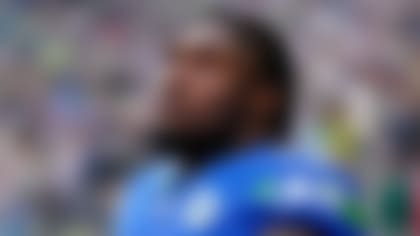For the second straight year, Wild Card Weekend produced three road winners. Wild, indeed! This sets up an enticing Divisional Round that features, in chronological order ...
1) A matchup between two extremely disruptive defensive fronts when Minnesota travels to San Francisco.
2) An underdog team led by the potential Comeback Player of the Year taking on a 14-2 juggernaut led by the likely MVP when the Titans visit the Ravens.
3) A rematch between two of the NFL's most exciting big-play quarterbacks when Patrick Mahomes' Chiefs host Deshaun Watson's Texans.
4) And two Super Bowl-winning quarterbacks squaring off at Lambeau Field.
There are so many interesting storylines and narratives that it's hard to hone in on what really matters. But here's the best part about creating models like mine: They have no bias. My model's "storylines" aren't influenced by anything other than how team attributes and performances line up against a large blend of historical, contextualized and situational data, as well as coach-vetted strategic inputs.
During the regular season, in games where my model returned 60 percent or higher confidence in the output, the accuracy in picking game winners was 74.8 percent (92-31). The way the model chooses these winners is by identifying the most important factors in determining each game's outcome. All of those factors also get a confidence rating. Then, after the game, the actual results (including the key factors that decided the outcome) are compared to the projected ones, and the model gets "graded." Factors with confidence ratings of 60-plus percent drive the final score accuracy (and also help contextualize rare events, like a blocked field goal). This is how the accuracy of the model improves each week -- and how my model projects which analytics-based storylines will be the most impactful in future games.
In preparing this article, I ran 200,000 simulations for every one of the seven remaining playoff games (1,400,000 total). Below, you'll find the following for each of the eight teams still trying to hoist the Lombardi Trophy: conference title probability, Super Bowl title probability and one high-confidence X-factor that the model flags as its analytics-based storyline. Use these objective components, combined with all the awesome subjective analysis available this week, to make your case for (or against) each team.
Without further ado, let's take a look, in alphabetical order ...
BALTIMORE RAVENS
Win conference: 41.9 percent.
Win Super Bowl LIV: 27.6 percent.
Analytics-based X-factor: Playing a team more than once in a season.
No team has had a more aligned personnel and play-calling strategy for their offensive players this season. The X-factor here is that rematches can be tough, from a historical perspective. With more film on a strategy and the players that comprise it, winning multiple times can be a daunting task. The Ravens will face the Titans for the first time this season on Saturday night, but they've already played the other two teams remaining on the AFC side: Baltimore whooped the Texans41-7 in Week 11 but lost to the Chiefs33-28 in Week 3. The Ravens have also squared off against two teams on the NFC side, beating the Seahawks30-16 in Week 7 and edging the 49ers20-17 in Week 13. Overall, Lamar Jackson is 1-3 in his second career meetings with NFL teams, suffering a 24-point reduction in passer rating the second time around (105.9 in Game 1 vs. 81.9 in Game 2).
GREEN BAY PACKERS
Win conference: 33.6 percent.
Win Super Bowl LIV: 17.5 percent.
Analytics-based X-factor: Pass catchers not named Davante Adams.
Despite only playing in 12 regular-season games, Adams logged 127 targets this season. That figure easily leads Green Bay, with running back Aaron Jones ranking second at 68 targets and tight end Jimmy Graham ranking third at 60. The next-closest receiver was Marquez Valdes-Scantling at 56. While Allen Lazard has the best results (with a 115.6 passer rating on 52 targets), the other pass catchers rate below-average in terms of my win-share measurement. Geronimo Allison and Valdes-Scantling have 87.5 or lower passer ratings when targeted and have accounted for more drops than the league average.
HOUSTON TEXANS
Win conference: 16.5 percent.
Win Super Bowl LIV: 3.6 percent.
Analytics-based X-factor: Downfield passing -- or the lack thereof.
Next Gen Stats show that, without Will Fuller as a deep threat, Watson stuck to short passes in the Wild Card Round, completing 15 of his 18 throws that traveled fewer than 10 air yards for 151 yards and a touchdown against the Bills. Watson only attempted two deep passes (20-plus yards), completing one for 41 yards. In career on- versus off-field splits with and without Fuller, Watson's passer rating on deep balls plummets more than 30 points when the receiver is absent. With Fuller, Watson had taken (16.5 percent of attempts vs. 10.1) and completed (43.2 percent vs. 33.8) more deep passes, piling up far better numbers (15.5 yards per attempt with a 14:8 TD-to-INT vs. 10.8 ypa with a 6:7 TD-to-INT). One of the reasons this flags is because Kansas City just lost stud rookie safety Juan Thornhill for the season, giving the Texans a better opportunity to exploit this part of the Chiefs' defense.
KANSAS CITY CHIEFS
Win conference: 27.6 percent.
Win Super Bowl LIV: 21 percent.
Analytics-based X-factor: How the secondary performs without Juan Thornhill.
Last week, I wrote about how the Chiefs' passing defense has been a strength, but losing second-round safety Juan Thornhill to a torn ACL could present a problem. Since Week 11, the Chiefs' defense has eliminated the downfield passing attack, allowing just a 22.6 passer rating on downfield throws of 10-plus air yards. That's not only lower than the passer rating assigned to throws that are grounded, but also the lowest in the NFL over that period (per Next Gen Stats). K.C. has allowed just 5.9 yards per attempt with a 2:8 TD-to-INT ratio on such throws since Week 11 -- both NFL bests. But on the play when Thornhill was injured, the Chiefs allowed just their second touchdown pass of 10-plus air yards since Week 11 (a 12-yard strike to Keenan Allen).
MINNESOTA VIKINGS
Win conference: 14.1 percent.
Win Super Bowl LIV: 3.2 percent.
Analytics-based X-factor: Rushing outside the tackles.
It's a little obvious to talk about Dalvin Cook as a big factor in general, but the connection to where he's rushing is more nuanced. A commitment to the run has driven a lot of success for the Vikings when Cook has been healthy. Against the Saints on Wild Card Weekend, Cook's first-half average of 5.4 yards per carry outside the tackles created a framework for ball control and success. Cook is one of just four players with 1,000-plus rushing yards outside the tackles this season and leads the NFL with 11 rushing touchdowns outside the tackles.
SAN FRANCISCO 49ERS
Win conference: 38.9 percent.
Win Super Bowl LIV: 21.2 percent.
Analytics-based X-factor: Dee Ford's health.
Last week, I wrote about the decrease in the Niners' defensive pressure over the past few games. One key to making this pressure-front work is Dee Ford. With Ford on the field this season, the Niners have pressured opposing quarterbacks on 36.3 percent of dropbacks. But without him, that figure drops to 22.7 percent. San Francisco's sack rate falls off a cliff, from 16.3 to 5.4, when Ford isn't on the field. Meanwhile, opposing quarterback figures significantly increase when No. 55's sidelined -- the TD-to-INT ratio goes from 3:4 to 20:8, while the passer rating jumps from 73.8 to 86.4.
SEATTLE SEAHAWKS
Win conference: 13.4 percent.
Win Super Bowl LIV: 2.8 percent.
Analytics-based X-factor: Jadeveon Clowney's impact.
According to Next Gen Stats, the Seahawks' pass rush has been significantly better with Clowney on the field, generating pressures (25.4 percent with him vs. 18.1 without) and sacks (6.1 vs. 3.9) at a much higher rate. It's worth noting that Seattle blitzes at a higher rate with Clowney on the field (30.1 vs. 24.1). The Seahawks' pressure rate (18.1) and sack rate (3.9) without Clowney would be the lowest in the NFL. Given all of their other injuries, the impact of this former No. 1 overall pick playing at 100 percent -- or close to it -- is crucial.
TENNESSEE TITANS
Win conference: 14 percent.
Win Super Bowl LIV: 3.1 percent.
Analytics-based X-factor: Linebacker health.
The Titans' defense has been very strong up the middle, thanks to the play of defensive tackles Jurrell Casey and Jeffery Simmons, linebackers Jayon Brown and Rashaan Evans and safeties Kevin Byard and Kenny Vaccaro. Defending this area of the field is one of the ways that projects to slow the Ravens. The problem is that Brown was injured on Wild Card Weekend, so we don't really know what to expect here, even if he plays. Overall, the Titans allowed 4.0 yards per rush during the regular season (ranking seventh), with just 15 rushes of 15-plus yards (tied for fifth-fewest). The Ravens led the NFL with 44 runs of 15-plus yards. Lamar Jackson individually led the NFL with 23 such runs. Brown is crucial in this specific matchup -- in the pass defense, too. Pro Football Focus counts him as only allowing an 81.9 passer rating in coverage this season, which is third-lowest among linebackers (min. 30 targets), behind only Jamie Collins (53.8) and Darius Leonard (79.0).
Follow Cynthia Frelund on Twitter @cfrelund.




